CHEVROLET CORVETTE 1996 4.G Owners Manual
Manufacturer: CHEVROLET, Model Year: 1996, Model line: CORVETTE, Model: CHEVROLET CORVETTE 1996 4.GPages: 386, PDF Size: 20.12 MB
Page 261 of 386
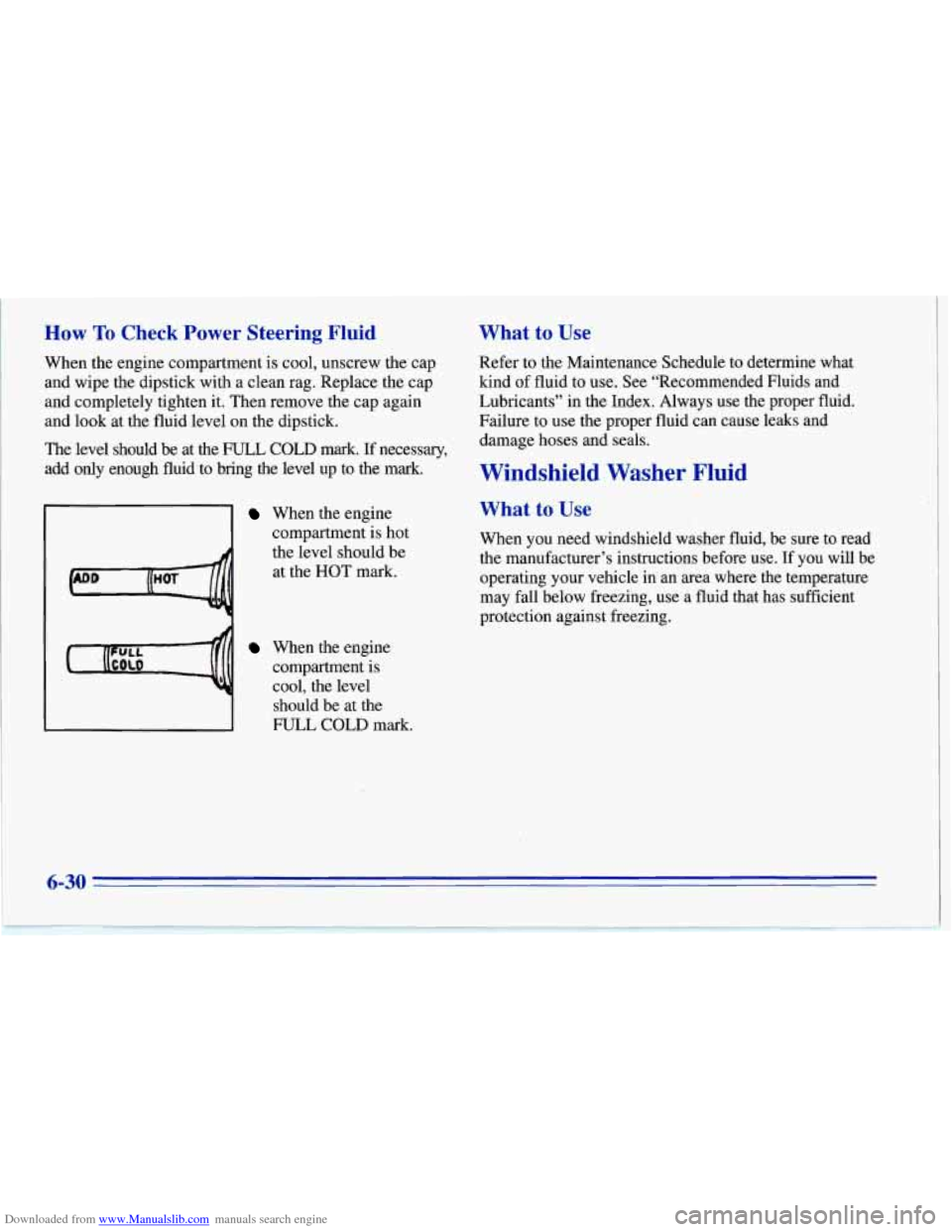
Downloaded from www.Manualslib.com manuals search engine How To Check Power Steering Fluid
When the engine compartment is cool, unscrew the cap
and wipe the dipstick with a clean rag. Replace the cap
and completely tighten it. Then remove the cap again
and look at the fluid level on the dipstick.
The level should
be at the FULL COLD mark. If necessary,
add
only enough fluid to bring the level up to the mark.
When the engine
compartment is hot
the kvel should be
at the
HOT mark.
[rfl
When the engine
compartment is
cool, the level
should be at
the
FULL COLD mark.
What to Use
Refer to the Maintenance Schedule to determine what
kind of fluid to use. See “Recommended Fluids and
Lubricants” in the Index. Always use the proper fluid.
Failure to use the proper fluid can cause leaks and
damage hoses and seals.
Windshield Washer Fluid
What to Use
When you need windshield washer fluid,.be sure to read
the manufacturer’s instructions before use.
If you will be
operating your vehicle in an area where the temperature
may fall below freezing, use a fluid that has sufficient
protection against freezing.
Page 262 of 386
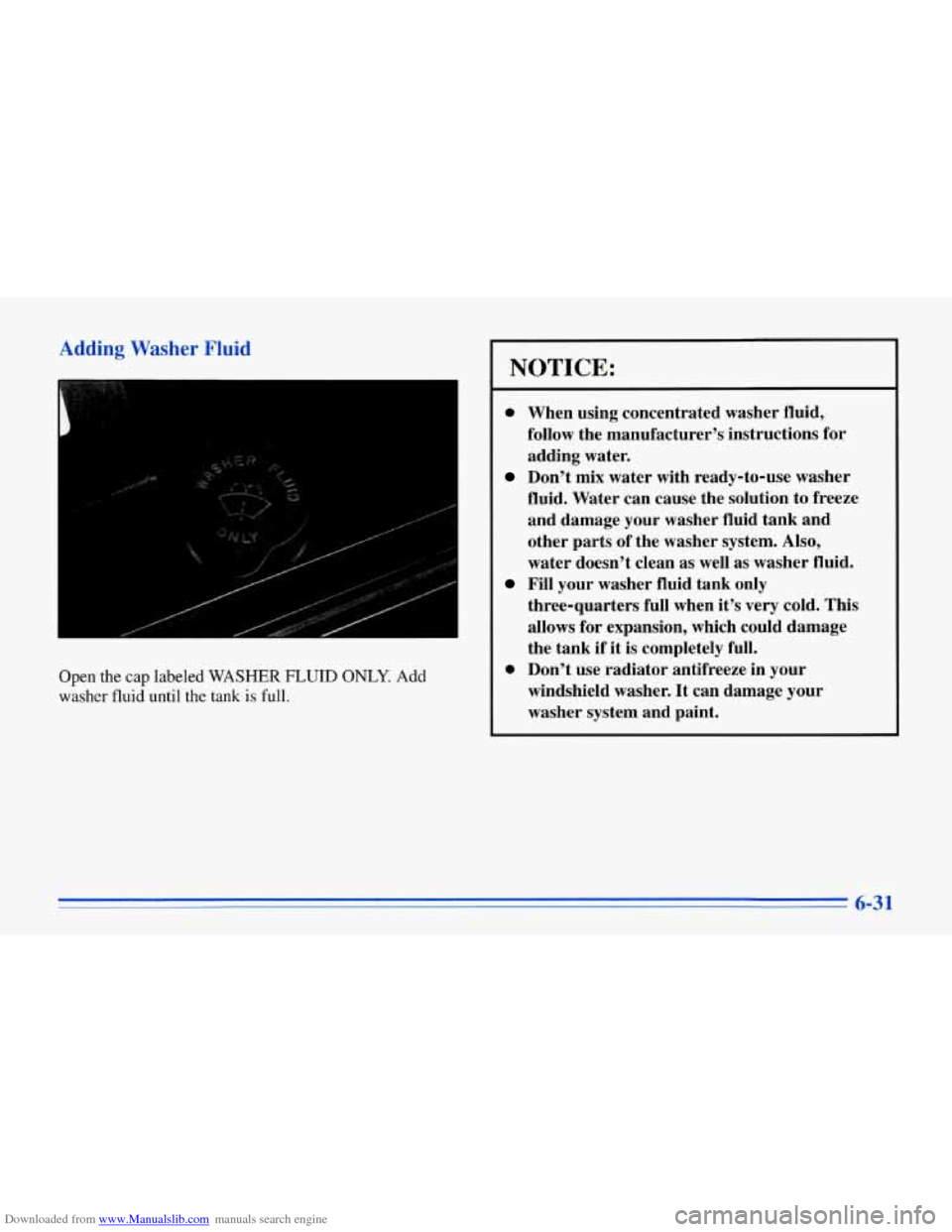
Downloaded from www.Manualslib.com manuals search engine Ai g Washer Fluid
Open the cap labeled WASHER FLUID ONLY. Add
washer fluid until the tank is full.
L
NOTICE:
0 When using concentrated washer fluid,
follow the manufacturer’s instructions for
adding water.
Don’t mix water with ready-to-use washer
fluid. Water can cause the solution to freeze and damage your washer fluid tank and
other parts of the washer system. Also,
water doesn’t clean
as well as washer fluid.
three-quarters full when it’s
very cold. This
allows for expansion, which could damage
the tank if it is completely full.
windshield washer. It can damage your
washer system and paint.
Fill your washer fluid tank only
0 Don’t use radiator antifreeze in your
6-31
Page 263 of 386
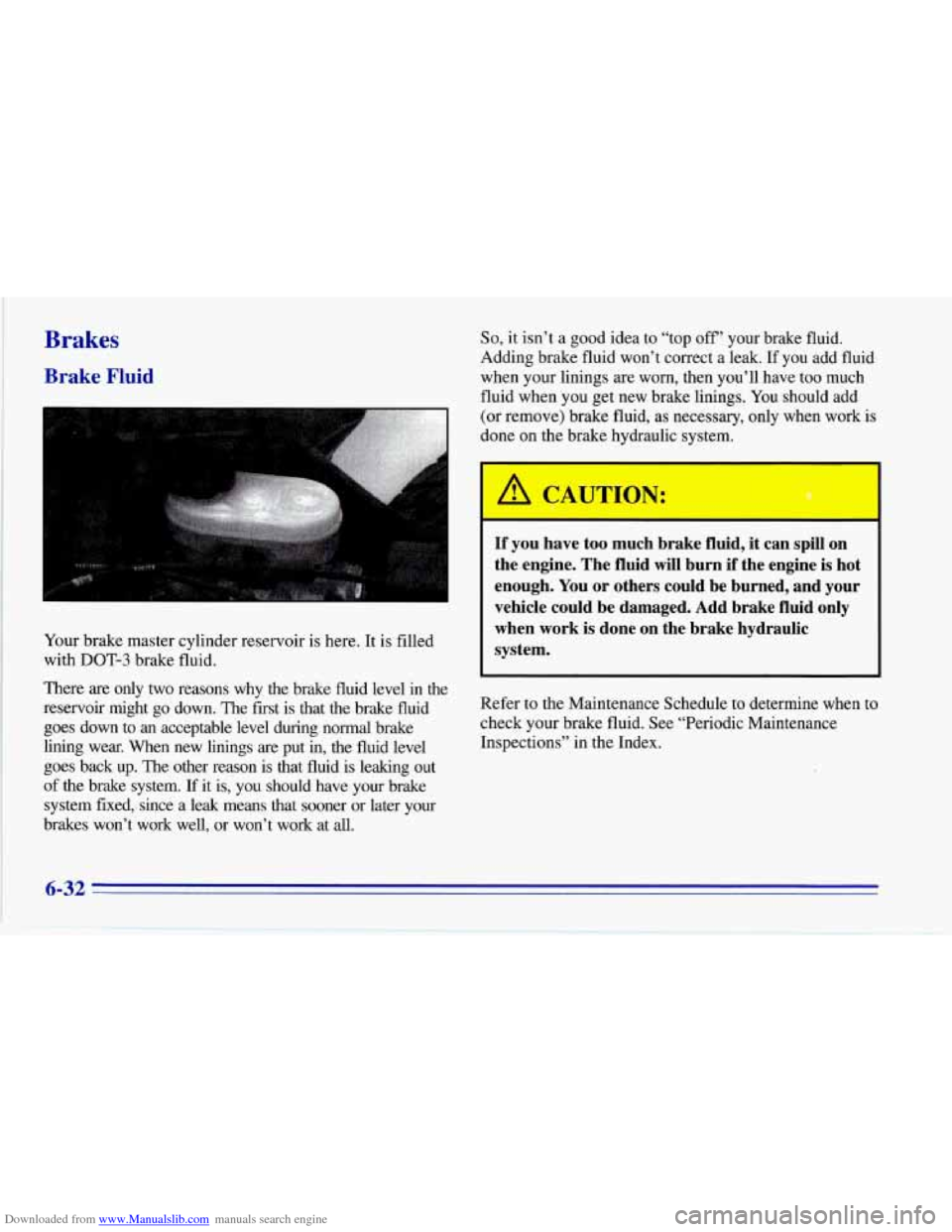
Downloaded from www.Manualslib.com manuals search engine Brakes
Brake Fluid
Your brake master cylinder reservoir is here. It is filled
with
DOT-3 brake fluid.
There
are only two reasons why the brake fluid level in the
reservoir might go down. The first is that the brake fluid
goes down to an acceptable level during
normal brake
lining wear. When new linings are put in, the fluid level
goes back up. The other reason is that fluid
is leaking out
of the brake system. If it is, you should have your brake
system fixed, since a leak means that sooner or later your
brakes won’t work well, or won’t work at
all.
So, it isn’t a good idea to “top off’ your brake fluid,
Adding brake fluid won’t correct a leak. If you add fluid
when your linings are worn, then you’ll have too much
fluid when you get new brake linings.
You should add
(or remove) brake fluid, as necessary, only when work
is
done on the brake hydraulic system.
--
A CAUTION: 3
-
If you have too much brake fluid, it can spill on
the engine. The fluid will burn if the engine is hot
enough.
You or others could be burned, and your
vehicle could be damaged. Add brake fluid only
when work
is done on the brake hydraulic
system.
Refer to the Maintenance Schedule to determine when to
check your brake fluid. See “Periodic Maintenance
Inspections” in the Index.
6-32
Page 264 of 386
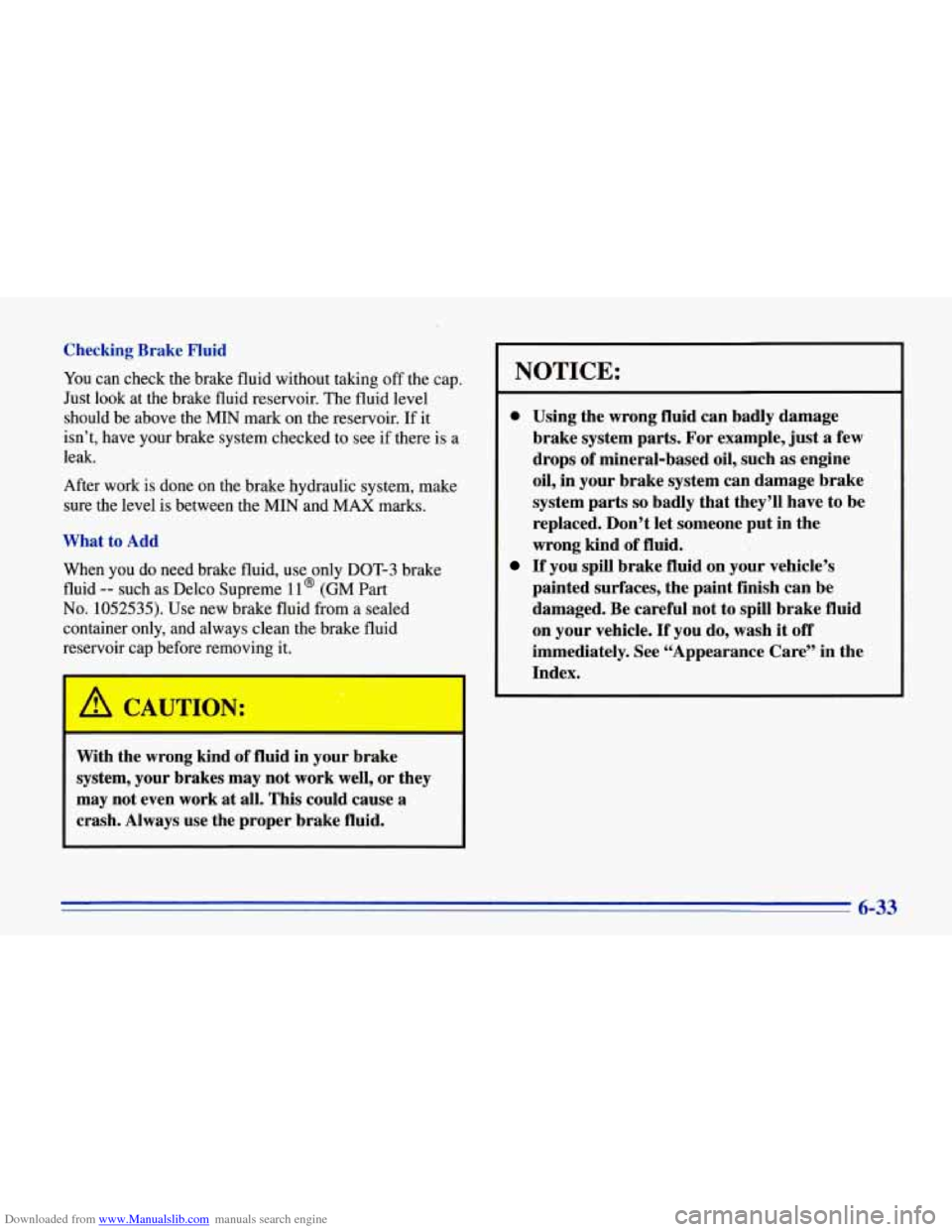
Downloaded from www.Manualslib.com manuals search engine Checking Brake Fluid
You can check the brake fluid without taking off the cap.
Just look at the brake fluid reservoir. The fluid level
should be above the MIN mark on the reservoir. If it
isn’t, have your brake system checked to see if there
is a
leak.
After work is done
on the brake hydraulic system, make
sure the level is between the MIN and MAX marks.
What to Add
When you
do need brake fluid, use only DOT-3 brake
fluid
-- such as Delco Supreme 11 @ (GM Part
No. 1052535). Use new brake fluid from a sealed
container
only, and always clean the brake fluid
reservoir cap before removing it.
1
With the wrong kind of fluid in your brake
system, your brakes may not work well, or they
may not even work
at all. This could cause a
crash. Always use the proper brake fluid.
NOTICE:
0 Using the wrong fluid can badly damage
brake system parts. For example, just
a few
drops
of mineral-based oil, such as engine
oil, in your brake system can damage brake
system parts
so badly that they’ll have to be
replaced. Don’t let someone put in the
wrong kind of fluid.
If you spill brake fluid on your vehicle’s
painted surfaces, the paint finish can be
damaged. Be careful not to spill brake fluid
on your vehicle.
If you do, wash it off
immediately. See “Appearance Care” in the
Index.
6-33
Page 265 of 386
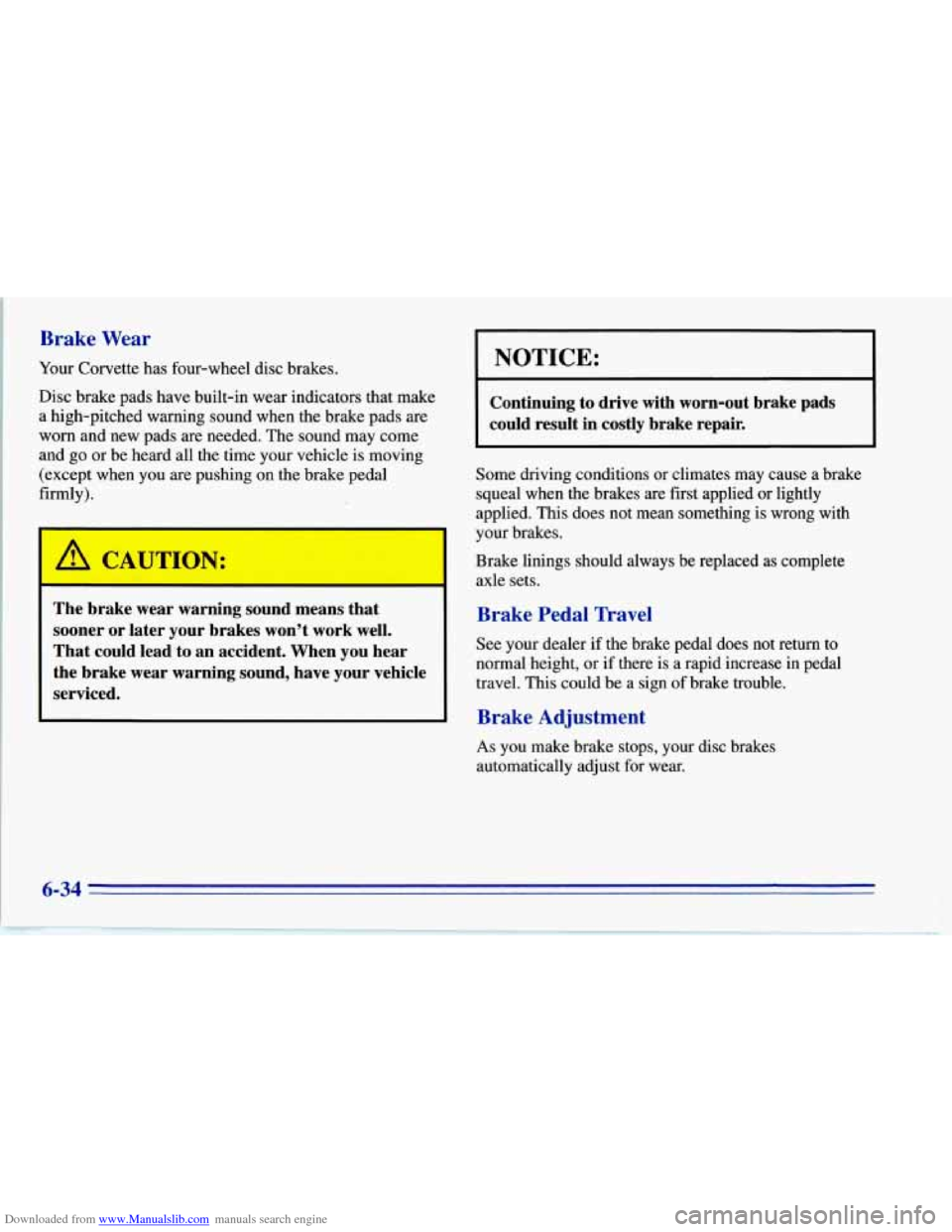
Downloaded from www.Manualslib.com manuals search engine Brake Wear
Your Corvette has four-wheel disc brakes.
Disc brake pads have built-in wear indicators that make
a high-pitched warning sound when the brake pads
are
worn and new pads are needed. The sound may come
and go or be heard all the time your vehicle is moving
(except when you
are pushing on the brake pedal
firmly).
I A CAUTION:
The brake wear warning sound means that
sooner or later your brakes won’t work well.
That could lead to an accident. When you hear
-.he brake wear warning sound, have your vehicle
I serviced*
NOTICE:
Continuing to drive with worn-out brake pads
could result in costly brake repair.
Some driving conditions or climates may cause a brake
squeal when the brakes are first applied or lightly
applied. This does not mean something is wrong with
your brakes.
Brake linings should always be replaced as complete
axle sets.
Brake Pedal Travel
See your dealer if the brake pedal does not return to
normal height, or
if there is a rapid increase in pedal
travel. This could be a sign of brake trouble.
Brake Adjustment
As you make brake stops, your disc brakes
automatically adjust for wear.
6-34
Page 266 of 386
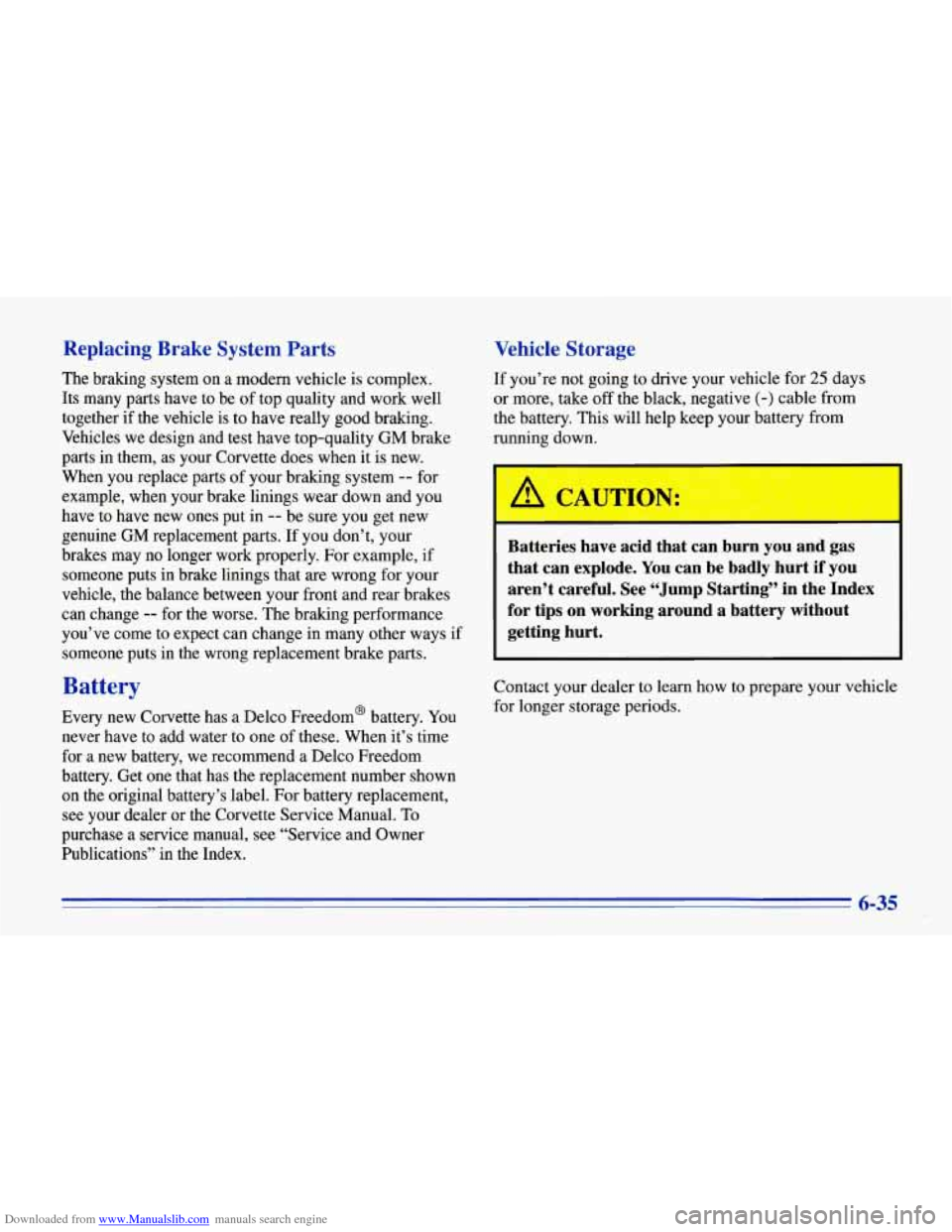
Downloaded from www.Manualslib.com manuals search engine Replacing Brake System Parts
The braking system on a modern vehicle is complex.
Its many parts have to be of top quality and work well
together if the vehicle is to have really good braking.
Vehicles we design and test have top-quality GM brake
parts in them, as your Corvette does when it
is new.
When you replace parts of your braking system
-- for
example, when your brake linings wear down and you
have to have new ones put in
-- be sure you get new
genuine GM replacement parts. If you don’t, your
brakes may no longer work properly. For example, if
someone puts in brake linings that are wrong for your
vehicle, the balance between your front and rear brakes
can change
-- for the worse. The braking performance
you’ve come to expect can change in many other ways if
someone puts in the wrong replacement brake parts.
Battery
Every new Corvette has a Delco Freedom’ battery. You
never have to add water to one of these. When it’s time
for a new battery, we recommend a Delco Freedom
battery. Get one that has the replacement number shown
on the original battery’s label. For battery replacement,
see your dealer
or the Corvette Service Manual. To
purchase a service manual, see “Service and Owner
Publications” in the Index.
Vehicle Storage
If you’re not going to drive your vehicle for 25 days
or more, take
off the black, negative (-) cable from
the battery. This will help keep your battery from
running down.
Batteries have acid that can burn you and gas
that can explode. You can be badly hurt if
you
aren’t careful. See “Jump Starting” in the Index
for tips on working around a battery without getting hurt.
Contact your dealer to learn how to prepare your vehicle
for longer storage periods.
Page 267 of 386
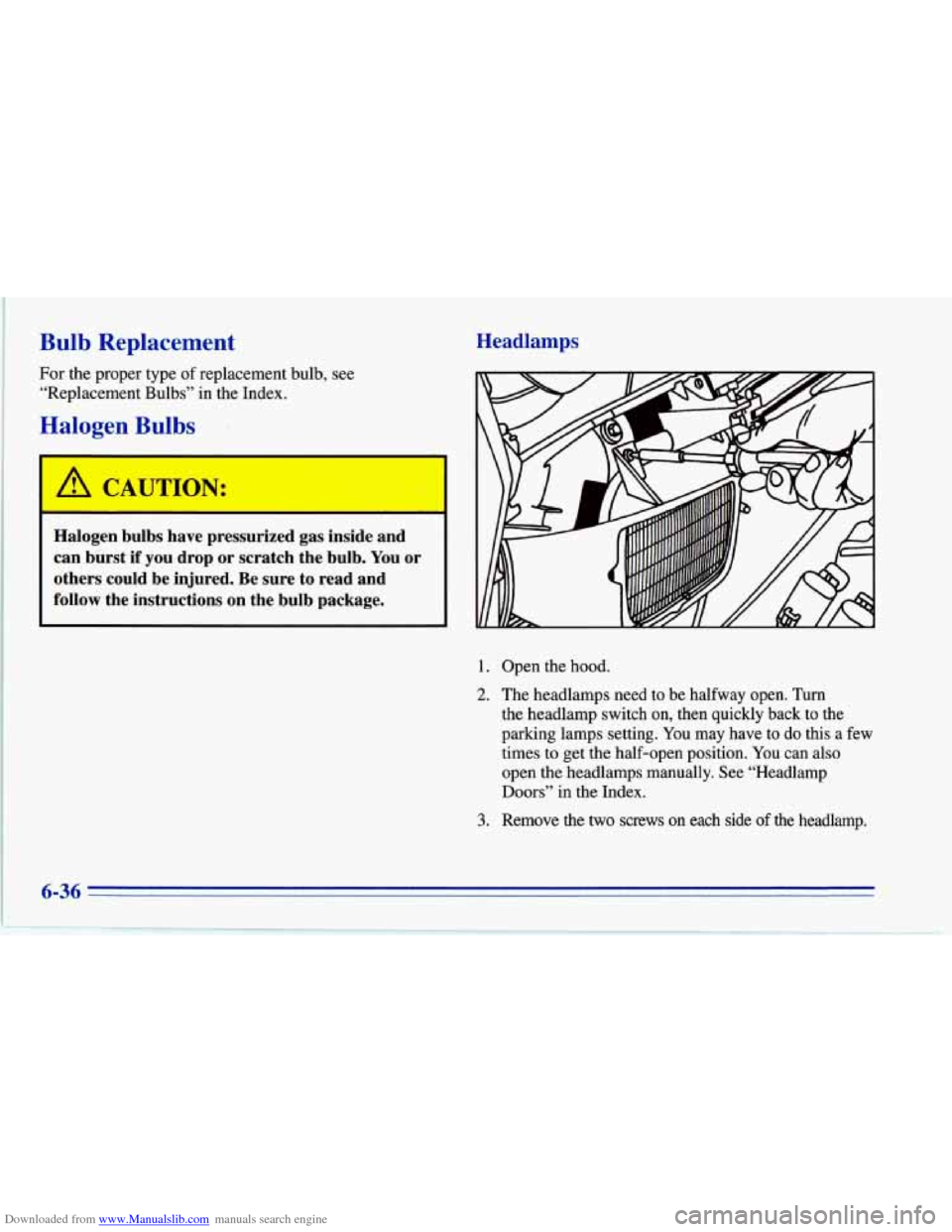
Downloaded from www.Manualslib.com manuals search engine Bulb Replacement
For the proper type of replacement bulb, see
“Replacement Bulbs” in the Index.
Halogen Bulbs
Headlamps
Halogen bulbs have pressurized gas inside and
can burst if you drop or scratch the bulb. You or
others could be injured. Be sure
to read and
follow the instructions
on the bulb package.
1.
2.
3.
Open the hood.
The headlamps need to be halfway open. Turn
the headlamp switch on, then quickly back to the
parking lamps setting. You may have
to do this a few
times to get the half-open position. You can also
open the headlamps manually. See “Headlamp
Doors” in the Index.
Remove the
two screws on each side of the headlamp.
6-36
Page 268 of 386
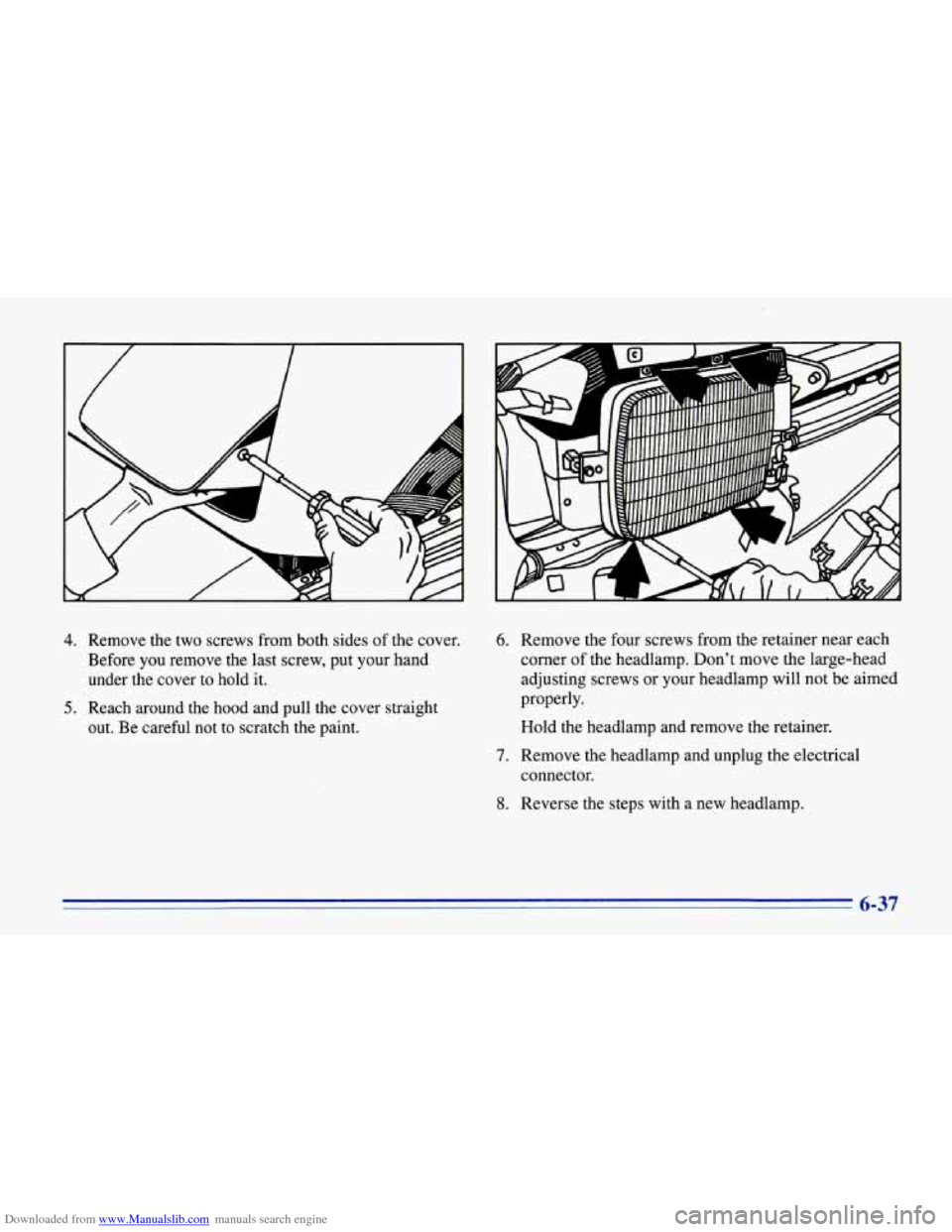
Downloaded from www.Manualslib.com manuals search engine 4. Remove the two screws from both sides of the cover.
Before you remove the last screw, put your hand
under the cover to hold it.
5. Reach around the hood and pull the cover straight
out. Be careful not to scratch the paint.
6. Remove the four screws from the retainer near each
corner of the headlamp. Don’t move the large-head
adjusting screws
or your headlamp will not be aimed
properly.
Hold the headlamp and remove the retainer.
7. Remove the headlamp and unplug the electrical
connector.
8. Reverse the steps with a new headlamp.
6-37
Page 269 of 386
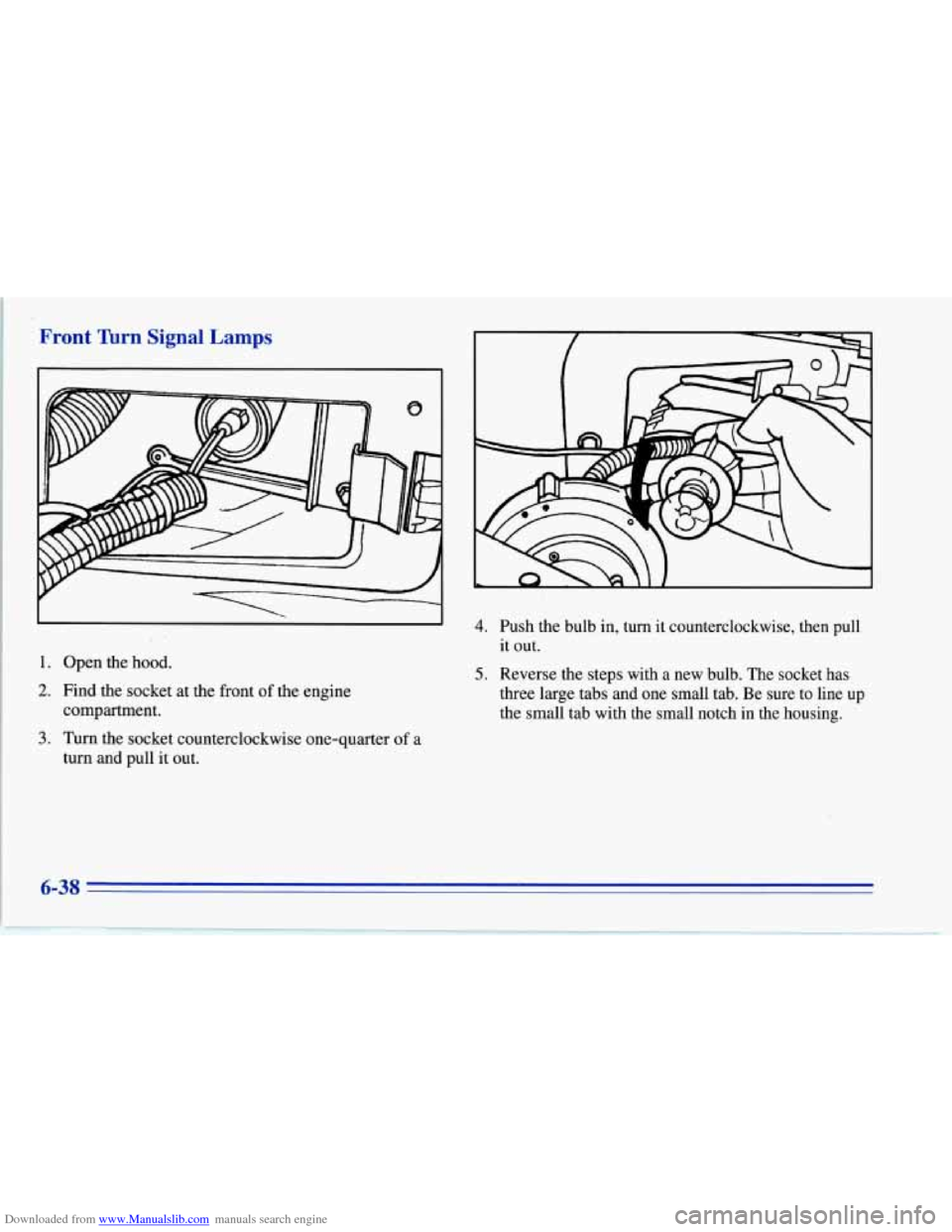
Downloaded from www.Manualslib.com manuals search engine Front Tbrn Signal Lamps
1. Open the hood.
2. Find the socket at the front of the engine
compartment.
3. Turn the socket counterclockwise one-quarter of a
turn and pull it out.
4. Push the bulb in, turn it counterclockwise, then pull
it out.
5. Reverse the steps with a new bulb. The socket has
three large tabs and one small tab. Be sure to line up
the small tab with the small notch in the housing.
6-38
Page 270 of 386
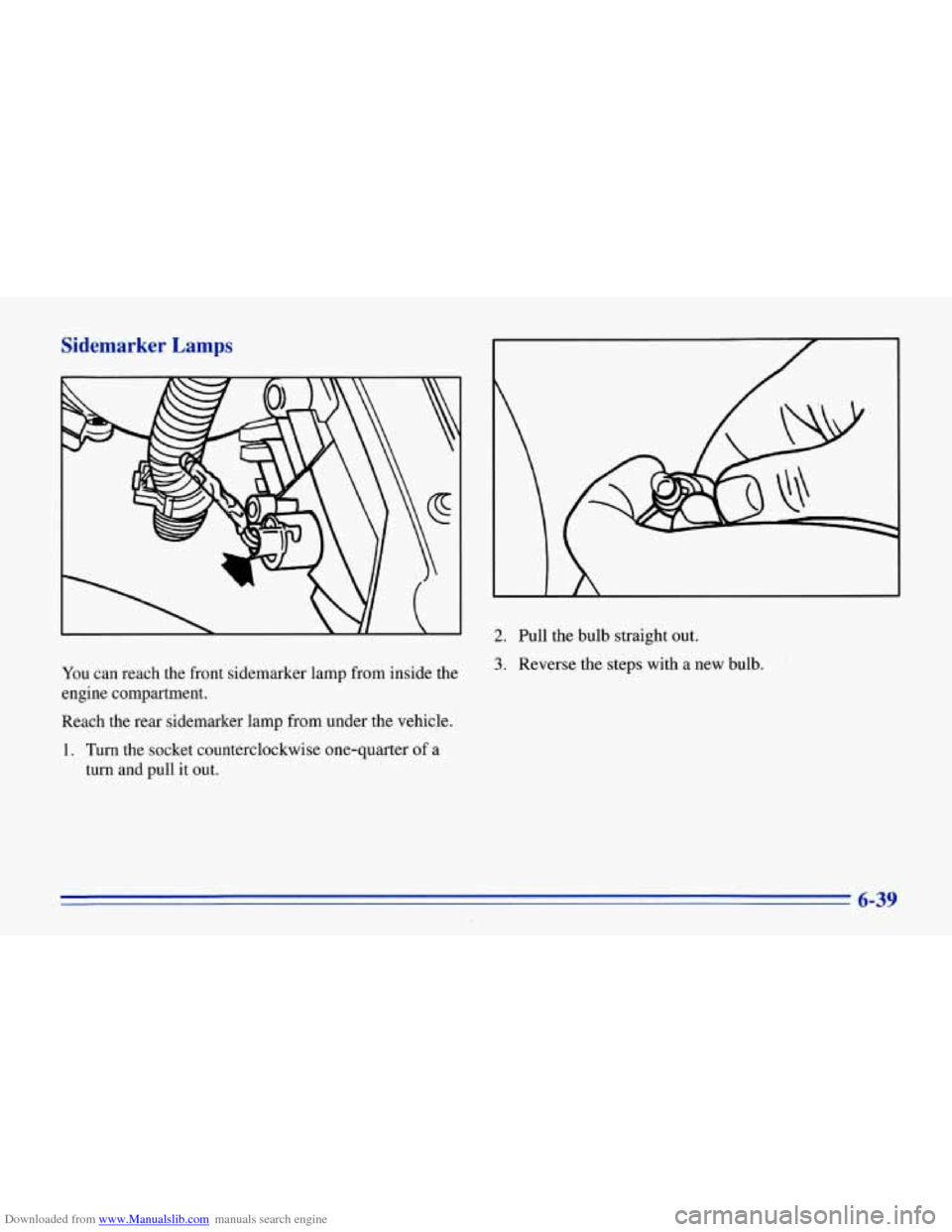
Downloaded from www.Manualslib.com manuals search engine Sidemarker Lamps
L
You can reach the front sidemarker lamp from inside the
engine compartment.
Reach the rear sidemarker lamp from under
the vehicle.
1. Turn the socket counterclockwise one-quarter of a
turn and pull it out.
2. Pull the bulb straight out.
3. Reverse the steps with a new bulb.
6-39